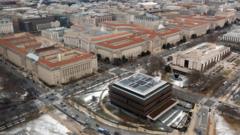In a bold and sweeping action, President Trump has signed an executive order aimed at reconfiguring the Smithsonian Institution's cultural framework, seeking to eliminate divisive narratives from its extensive array of museums and research centers. The Smithsonian, which attracts millions of visitors each year across its 21 locations in Washington D.C. and New York, will now focus on restoring what Trump defines as a truthful representation of American history.
The order mandates Vice-President JD Vance to oversee the removal of what Trump characterizes as "improper, divisive, or anti-American ideology" from Smithsonian institutions, including its famed museums and the National Zoo. Furthermore, it calls on the Secretary of the Interior to take action in restoring any "federal properties" that have reportedly been altered in recent years, which Trump claims have propagated a distorted version of history—a mission he has dubbed "Restoring Truth and Sanity to American History."
Within this context, Trump's order urges Congress to cease funding any Smithsonian initiatives that could be perceived as racially divisive. The directive raises concerns regarding the upcoming American Women's History Museum, claiming it intends to promote unconventional gender identities and criticizes the National Museum of African American History and Culture for allegedly labeling values like "hard work" and "individualism" as traits of "White culture."
The Smithsonian, which offers complimentary entry to an estimated 15-30 million visitors annually, includes renowned institutions like the National Museum of American History and the National Portrait Gallery. Trump’s order extends to instructing Secretary Doug Burgum to initiate enhancements to notable locations, including Independence Hall, in anticipation of the quarter-centenary marking the signing of the Declaration of Independence.
These recent actions reflect Trump's ongoing mission to counter what he describes as the encroachment of 'woke' leftist ideology into American culture. Previously, he attempted to eliminate diversity and inclusion programs from federal agencies, resulting in several legal confrontations. His tenure has previously seen significant controversies, such as his unilateral shifting of leadership at the John F. Kennedy Center for the Performing Arts, an act that drew public outcry from various artists and influenced scheduled performances.




















